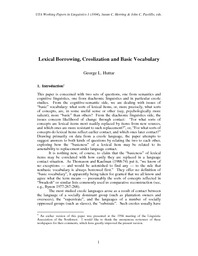| dc.description.abstract | **Please note that the full text is embargoed** ABSTRACT: This paper is concerned with two sets of questions, one from semantics and cognitive linguistics, one from diachronic linguistics and in particular creole studies. From the cognitive-semantic side, we are dealing with issues of “basic” vocabulary: what sorts of lexical items, or, more precisely, what sorts of concepts, are, in some useful sense or other (say, psychologically more salient), more “basic” than others? From the diachronic linguistics side, the issues concern likelihood of change through contact: “For what sorts of concepts are lexical items most readily replaced by items from new sources, and which ones are more resistant to such replacement?”, or, “For what sorts of concepts do lexical items reflect earlier contact, and which ones later contact?” Drawing primarily on data from a creole language, the paper attempts to suggest answers to both kinds of questions by relating the two to each other, exploring how the “basicness” of a lexical item may be related to its amenability to replacement under language contact.
It is nothing new, of course, to claim that the “basicness” of lexical items may be correlated with how easily they are replaced in a language contact situation. As Thomason and Kaufman (1988:74) put it, “we know of no exceptions — and would be astonished to find any — to the rule that nonbasic vocabulary is always borrowed first.” They offer no definition of “basic vocabulary”, it apparently being taken for granted that we all know and agree what the term means — presumably the sorts of concepts reflected in “Swadesh” or similar lists commonly used in comparative reconstruction (see, e.g., Bynon 1977:267-268).
The most studied creole languages arose as a result of contact between the language of a socially dominant group (such as plantation owners and overseers), the “superstrate”, and the languages of a number of socially oppressed groups (such as slaves), the “substrate”. Such creoles usually have lexical items clearly derived from both superstrate and substrate sources. Let us assume for now — the assumption will eventually be challenged in §4 below — that the substrate languages represent in some sense an earlier stage of the creole that eventually emerged. In that case identifying the sorts of concepts for which creoles tend to use superstrate-derived forms, and those for which they use substrate-derived forms, gives us a way of answering our question about which sorts of lexical items are more amenable to replacement from new sources. In addition, some creoles, such as those of Suriname, have had contact with a number of superstrate languages in succession during their history. Since it is often possible to identify from which superstrate language a particular lexical item is derived, these languages provide an additional way to answer that same question, to the extent to which the order of contacts with the various superstrate languages is known. | en_US |


